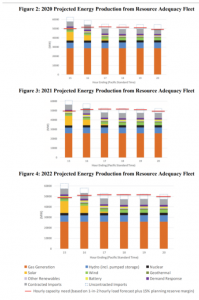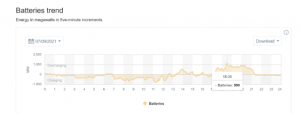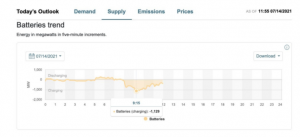A new player is taking the stage in the highly charged California electricity market. Enter lithium-ion energy storage.
The world saw this revolution coming years ago, but momentum has been accelerating ever since the summer of 2019, when California regulators and utilities first predicted peak hour shortfalls in September of 2020.
The regulators noted that the “peak hour of [electricity demand in] the year occurs consistently in September… within hour ending 17 (based on P.S.T. or 6:00 p.m. P.D.T.). By 2022, the peak shifts to hour ending 18.”

As we see in the chart (and noted by the white boxes defined as “uncontracted imports”), there are three to four hours where regulators predict a shortfall.
In 2020, that shortfall totaled around 6,000 MWh over three hours. In 2021, regulators added an hour and increased the amount of shortfall within each one-hour window, bringing the total shortfall to 14,400 MWh. That number expanded again in 2021 to 15,400 MWh of “missing energy” over four hours.
To manage the shortfall (and to compensate for a nuclear power plant that is about to close), California recently decided to procure 11.5 GW of clean energy sourced resource adequacy by 2026. That represents instantaneous capacity, a number which many of the energy storage systems must sustain for a minimum of four hours.
The procurement requires some percentage of that clean energy to be available as longer-term storage, for roughly 10 hours. That could translate to more than 60 GWh of clean energy storage added to the grid in the next half decade.
That’s a massive quantity of energy storage in California’s future. But as climate scientists increasingly sound the alarm over California’s megadrought-caused fires, an increasing sense of urgency exists.
Fortunately, 2,000 MW of energy storage capacity is coming online by August 1, per the California Public Utility Commission. Much of this capacity will have four hours of battery energy sitting behind it, nearly 8,000 MWh in total.
As a preview of what that capacity has to offer, we’re getting our first glimpses via the California ISO Supply charts.

On July 9 at 6:30 PM, California’s main grid noted that energy storage injected 999 MW of power during a “flex event” where rolling blackouts might otherwise have occurred.
Note the battery charging periods, here too. As California’s daytime solar capacity grows, energy storage will increasingly arbitrage the cheap electricity to the point where energy storage may become the evening time’s baseload capacity.
One of the first examples of a huge charging event occurred on July 14 at 9:15 AM, and was brought to our attention by California energy data geek Joe Deely. Here’s what it looked like:

A retroactive analysis of wholesale electricity pricing at the time might give us an indication as to why these batteries were chosen to charge at this point.
Two of the world’s largest lithium ion batteries contributed to these capacity values, and backed up the grid during the flex event.
The first is LS Power’s 230MW lithium ion energy storage facility, which was scheduled to increase from 230MWh to 690MWh by this summer, and add more capacity at a later date. This plant is, for a moment anyway, one of the world’s largest lithium ion grid connected batteries.
The second facility is Moss Landing’s 300 MW / 1,200 MWh facility – again, one of the largest in the world for now – which joined the grid in December 2020. This facility might soon expand to 1.5 GW / 6 GWh.
Let’s all hold on, because — not too far into the future — we’ll see 1.21 GW… Doc Brown’s flux capacitor optional.






